The next stamp we expose as fake is part of the Washington / Franklin regular issue of October 1917. It has a double line watermark and is perforated 11 all around on a common perforation gauge. It was produced by the FLAT PLATE press printing method, and popped out of the presses in sheets of 400 subjects in 4 panes of 100.
This is one of the most commonly faked stamps because it is so easily made from a Scott 344.
This is an ongoing experiment, so it will be evolving over the next year depending on my schedule. It was inspired by several eBay users / dealers and collectors who have e-mailed over the last few months, and warned me about various unscrupulous sellers who make quite a cash flow selling altered common stamps as rarities. Basically, modifying cheap stamps and selling them "as is" or "reference", which in polite company means a forgery or fake. Surprisingly, many people don't read the fine print and usually pay a lot of money for something that is basically worthless. I did, and though in most case's it didn't hurt very badly, I am now here to help educate you to not make the same mistake I did.
New Rev5.1 Design, November 2007
Buy the Sonic Imagery Labs Specialty Perforation & Grill Multi -Gauge
Download Instruction Sheet for the Sonic Imagery Labs Specialty Perforation & Grill Multi -Gauge
Download a MAIL ORDER form for the Sonic Imagery Labs Specialty Perforation & Grill Multi -Gauge
Another Bogus Scott 519 - New November 2002
The Fake Scott 346 Private Perf - New October 2002
The Most Impressive Fake Scott 62B
The Secret Life of an Altered Scott 72
The Secret Life of a Chemically Altered Scott 78
The Secret Life of an Altered RW5 Duck Stamp
A Fake Scott #320 with Schermack Type III Perforations
Fake Scott #743a
Detecting a Flat Plate Press Vertical Coil, Fake Scott 441
Fake Reperfed 514a
Fake Reperfed 508c
Fake Reperfed 546
Fake Scott 143 w / Bogus Grill
Fake Scott 137 w / Same Bogus Grill as Fake 143
Fake Scott 139 w / Same Bogus Grill as Fake 137 and 143
Fake Scott 315 - Revised June 2002
Fake Reperfed Scott 519 - Revised June 2002
A Gallery of Bogus Stuff Part 1
A Gallery of Bogus Stuff Part 2
A Gallery of Bogus Stuff Part 3
A Gallery of Bogus Stuff Part 4
A Gallery of Bogus Stuff Part 5
Credits, Inspiration and Links of Interest
Bibliography of Research Material I Use for this Site
Download the Schermack Type III Go-NoGo Gauge
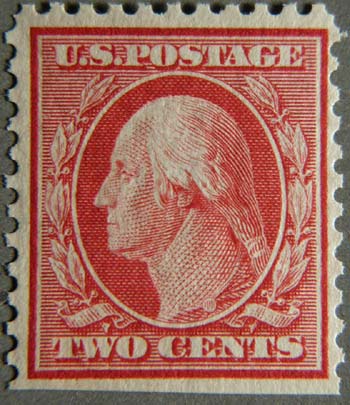
This was purchased at the end of last summer 2001. I don't remember who I purchased it from. If anyone out there knows how I can find a listing of all my purchases going back farther than 30 days, please e-mail me so I can reveal the seller. Half the fun of doing this is revealing who the sellers are.
This stamp on the left is supposed to be a Scott 519. Its an oddball from the Washington-Franklin Series of stamps. This series can be the bane of all beginning US collectors. Fortunately there are some really wonderful websites out in cyberspace that can make identifying the zillion different varieties of this series quite easy! The one that comes to mind is www.1847usa.com.
The 519 variety came about in 1917 when some postal center returned an old stock pile of Scott 344 back to the Bureau of Engraving. The bureau took the pile of imperforate sheets and perfed them with the standard 11 gauge perfs that where being used at the time. The 344 was originally produced in 1908. By 1917 the design had changed to the more familiar numeral 2 cent design. That's why this guy is an oddball and quite valuable if genuine.
Our subject today appears to the naked eye to be a Scott 519 of which the 2002 Scotts Specialized Catalog of US Stamps and Covers states it's value at $400 mint and $1100 used.
I am pretty sure that I have previously mentioned elsewhere in this website that this catalog is the greatest $40.00 investment one could ever make! It needs to be restated because below the listing for the 519 it says "Beware of copies of No. 344 fraudulently perforated and offered as 519." Hey isnt that what the Bureau of Engraving did? Yes, but they have really nice machines that make really nice perforations that fakers have a hard time duplicating.
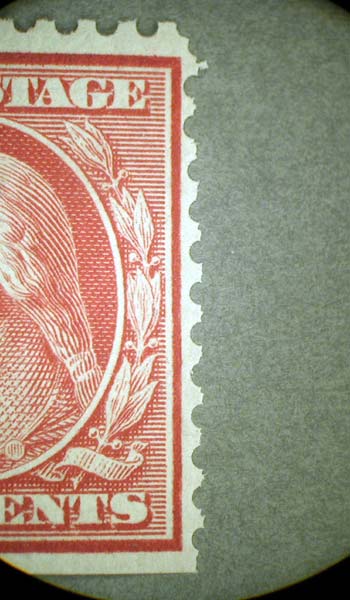
Our lesson for today is to examine this fraudulent 519 and learn how to recognize the tell tale signs of a reperforation job. This subject stamp has all the classic traits of a fake.
The first flag of suspicion is the bottom edge. There shouldn't be an unperforated edge. It is possible for someone in the stamps past life to have cut the perfs off so if it's genuine it should have a certificate stating such. Look at the previous image. The straight edge is not... well.... straight. Yup, it's crooked. The Bureau is usually very good at cutting straight. Fakers are typically not good at cutting things very straight. Most likely the reality was that this was a block of imperf 344's and the faker didn't have enough edge to put his phony perfs on. If he had perfed this edge the stamp would be smaller than the norm and that would of raised more suspicion.
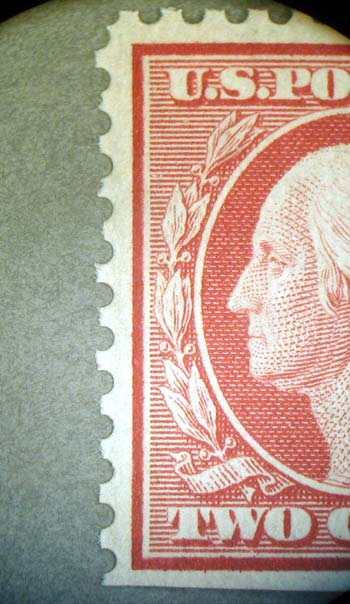
The next thing to notice and take note of is the perforation holes are all perfectly round. This isn't the norm. Real perforation holes are usually slightly oblong. The inside edges are also usually rough with paper fibers sticking out in random directions.
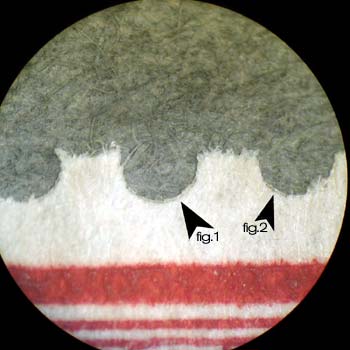
Here's a close-up of the bogus perforations. The arrow noted as figure and fig. 2 are pointing at the beveled edge that is created by the fakers tool or punch pinching the paper before it cuts through. The holes of the fake perfs are to clean and sharp. I finally got a sharp image of the slight bevel on the fake hole which is never present on genuine stamps of this series.
Here's a fun experiment. Take an ordinary store bought fresh paper punch. The squeezy kind that schools make the kids buy in September. Punch a piece of 24 - 40lb. white laser printer paper and look at it under high magnification and you will see a ridge and bevel like the fake. That's because the punch is ever so slightly larger than the hole it cuts through and crushes and pinches the paper flat before actually cutting through it. US stamps of this era do not have this characteristic. At least I cannot find it in any of my genuine stamps. Perforations are cut with rotary perforation pins and dies, as a paper punch type method would wear out very quickly. A steel pin die can also be easily replaced and sharpened. (Someone e-mail me about this as my manufacturing knowledge gets a little thin here.)
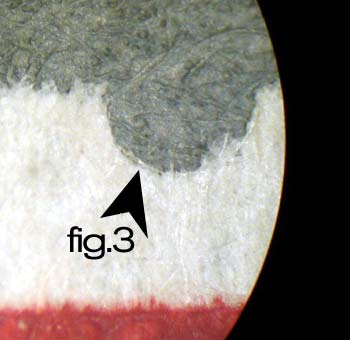
In this image (figure 3) I finally also captured the flecks of metal that the fakers tool leaves behind as it is pushed and pulled through the paper. I am guessing that the fakers use a block of metal with holes drilled in it. And a device like an awl, the same diameter as the holes in the block of metal. The awl is pushed through the stamp and into the hole of the metal block. It is then pulled out and moved to the next hole position and repeated. Imagine a voting machine and punching a ballot. (I have a few real stamps with "chads" on them. Remember chads?) :-)
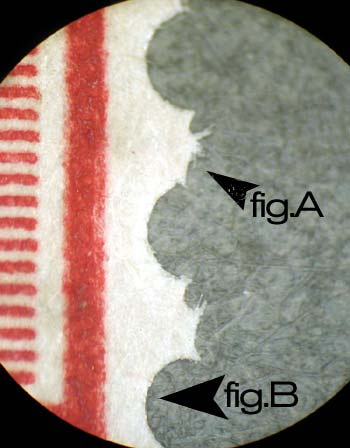
Figure A is pointing at the next trick that fakers use. Since this was originally an imperforate stamp, the edge that was straight has no stamp next to it. When the faker punched his holes, he had to disguise the straight edge and make it appear that a stamp was there and that it was torn or pulled away. What the faker did here was to randomly cut each side of the tip and then pull the end off. This leaves a small straight edge with a bundle of fibers sticking out.
This leads me to another point. Look at the first image at the top of this page. Now look at the last image on this page The fibers at the tips of the perfs along the top edge are what really happen when the adjacent stamp is pulled off. The point here being that there are 3 or more fakes that where attached to this fake floating around in the world right now.
Fig. B is that super clean edge in close-up. (I love microscopes.)
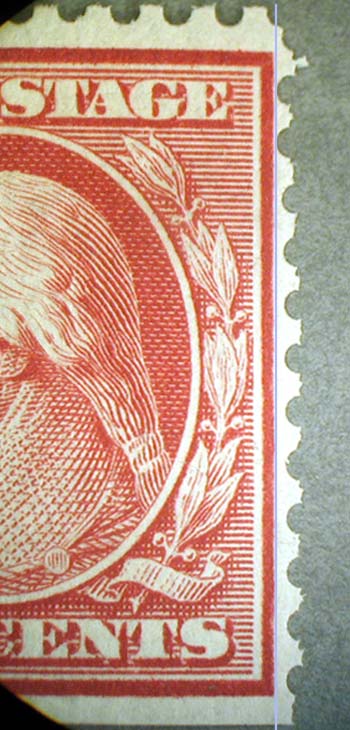
Fakers always blow it somehow. (Good thing too.) The faint blue line is a straight guide line that I added to illustrate my next point. On genuine stamps, perforations are usually very straight and equal distance from the border or edge of the stamps design. The fakers holes are not.
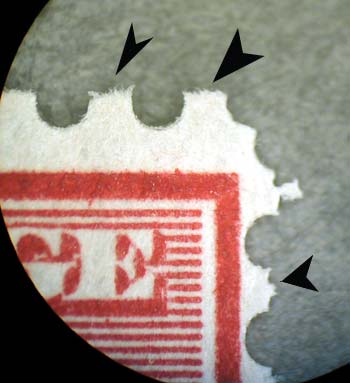
The close up view of the top edge shows what happens to the paper when the adjacent stamp is pulled away. Notice the fibers sticking out. The right side of the fake doesn't have this characteristic because no stamp existed on this side when it was reperfed.
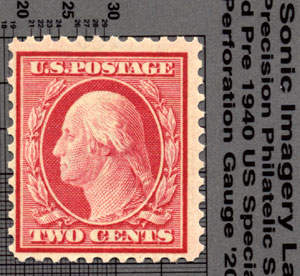
This is a real Scott 519. The Washington / Franklin's are my specialty. Here is what to look for while thinking about buying a 519 without a Certificate from an expert committee.
1. Obviously it should have a double line watermark.
2. Measure the perforations. They should measure 11-72 on a "Specialist Gauge" or 10.94 on an analog gauge.
3. The perforations are fairly sharp and cleanly cut. This is because the imperforate sheets of 344 aged for several years before being perforated at the BofPE. They will, however, show a slight roughness inside the hole that is consistant within the rows.
4. The holes are not perfectly round, but appear somewhat flattened.
5. Many examples of this issue have paper and gum that is slightly yellowish. However, this is not true for all genuine examples. My 519, shown to the left, has this feature.
6. Color is also an important consideration with this stamp. Genuine copies are a dull shade of carmine. Light carmine or bright carmine examples are made from imperforate stock other than the 344.
7. As you can tell from my previous points 3 thru 6, this is a difficult stamp the expertize without a genuine copy to compare against. If one doesn't own a known genuine, it might be best to purchase one with a expert committee's certificate. I stared at my copy for days and days and still I was only 60% sure.
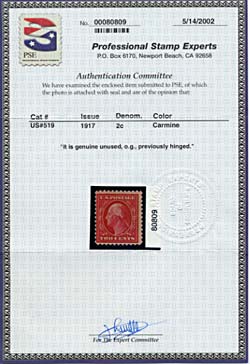
I said this before at the top of this page. I am going to say it again. This stamp is the most faked stamp of the Washington Franklin series. If the seller doesn't have a cert, and is selling it "as is", odds are 8 in 10 that your going to be sorry.
Thanks for visiting this site. I hope you learn something new as I am having fun doing this and stirring up the "doodoo" so to speak. You, the visitor, have my permission to copy my pages and images for the purpose of showing others how to look for fakes and forgeries. You also have my permission to link to my pages and to share the link paths to others. I only ask in return for you to send me an e-mail if I have made a mistake or have done some other technical blunder that in my rush to put these pages up would cause the visitor confusion. Please also visit my other website www.slingshotvenus.com and support the live music arts.